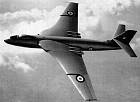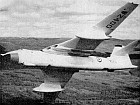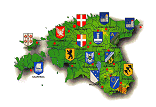Aircraft Profile #66. Vickers Valiant |
|
|
At the end of W.W.II, Bomber Command of the Royal Air Force was due to be completely re-equipped with the B.14/43 Avro Lincoln and the B.3/42 Vickers Windsor. Only the Lincoln went into production and the prevailing operational philosophy, which included heavy defensive armament and unpressurised crew accommodation, remained static. In the meantime the arrival of the turbojet engine and the nuclear bomb completely altered the picture. Their influence on Air Staff requirements was profound. If a single weapon could do the work of a thousand-bomber raid of the war, there was no longer the need to maintain a large bomber force. Very high speeds could be attained with the steep rise in power output obtainable from the jet engine and very high operational ceilings could be reached by the introduction of pressure cabins, first explored and developed by Vickers in the Wellingtons V and VI. No defensive armament would be needed in a high speed, high altitude bomber and electronic equipment would provide precision bombing at the elevated speeds and heights made possible. Therefore the On the other hand, international incidents like the Berlin blockade and air lift and the events leading up to the Korean war and Suez lent urgency to the weighty and vital task of the complete and revolutionary re-equipment of British air forces, notably Bomber Command. In other words, the general consensus of public thinking in Britain favoured the policy of rebuilding British military strength through the rearmament drive. Thus the V-bomber force was born. It would have the
Consequently an Air Staff requirement of 1947 led to the projecting of advanced designs for new jet bombers embodying wings of some 35 degrees sweep-back on which the results of theoretical research were available. Such a configuration of wing plan delayed compressibility effects at Mach numbers approaching the speed of sound and this technical consideration eventually led to two decisions. One was to seek an aerodynamically advanced form with better performance characteristics and high development potential and the other was to order a less radical design with inferior performance to that of the more advanced types. This latter conception in fact materialised as the Short Sperrin prototype, which was designed and constructed as an insurance against the possible failure of the more ambitious designs. Vickers submitted a tender
Air Ministry Specification B.9/48 was drawn up around the Vickers design which was allocated the number 660 in Vickers Type list. The prototypes were ordered by contract on 2nd February 1949, the first to have four Rolls-Royce Avon R.A.3 turbojet engines and the second prototype, as Type 667, to be powered with four Armstrong Siddeley Sapphire turbojets. Design proceeded in 1949, and in 1950 components were being made into complete assemblies at the Foxwarren experimental shop under the direction of Mr. A. W. E. (Charlie) Houghton, the then manager responsible for prototypes. Although the bomber was ordered "off the drawing board" in the modern manner, prototypes were still required at the time the
Final assembly of the new bomber began early in 1951 at Wisley and the first flight was made by J. "Mutt" Summers, accompanied by G. R. "Jock" Bryce, from the grass airfield there on 18th May 1951. This flight was a short one and only three more were made from Wisley before flight trials were transferred to Hum, while a hard runway was being constructed at Wisley. The prototype Type 660 bore the serial number WB210 and in June 1951 the Vickers bomber was officially called the Valiant, a repetition of the name used for Vickers Type 131 of 1931, a single-engined military tractor biplane. Flight testing of WB210 continued until 12th January 1952 when the aeroplane had to be abandoned in flight because of a fire in the port wing during stop and start tests in the air, concerned with internal noise level tests. All the flight crew except one, Sqn. Ldr. Foster - Early flight trials of WB210 had given sufficient indication of the promise of the design to satisfy the Air Staff. Completion of the second prototype, Type 667, was near so the loss of WB210 was not as serious as it might have been in the absence of the original orders for three prototypes. This second Valiant, WB215, flew on 11th April 1952 at Wisley with R.A.7 Avons and not with Sapphires as originally planned. An initial order for 25 Valiant B.1s had been placed in April 1951. The production of so large an aeroplane of technical complexity involved a considerable planning effort with a large amount of sub-contracting. Eight major sub-contractors were chosen, with Saunders-Roe responsible for the largest item, the pressurised crew compartment. Because of the shortage of suitable steel sections, pre-stressed concrete was employed for the interchangeable jig pillars, bolted to the shop floor. VALIANT CONSTRUCTION New production The Valiant was a "shoulder" wing aeroplane with variable sweep on the leading edge. The four Avon turbojets were buried in the inner wing as was British practice at the time of design, contrasted with the contemporary American practice of engine pods underslung below the wing. The intakes were long rectangular slots extending from the wing root leading edge outboard in the first prototype. Before the first flight, vertical airflow straighteners were added in the mouths of the intakes but in subsequent Valiants the familiar "spectacle" type entries were adopted to
With the shoulder wing configuration, a cavernous bomb-bay was provided in the circular section fuselage and so the Valiant became in due course the first of the "V" bombers capable of accommodating the Blue Steel "stand-off" weapon. The tailplane was mounted part-way up the vertical fin to be well clear of the jet efflux. With a large wing and consequently a comparatively low loading the requirements for short take-off and long range were adequately met by the Valiant. A broad chord inboard enabled the root thickness to be no more than twelve per cent, although embodying sufficient depth to accommodate the power units with their ancillary systems and accessories. In addition, this wide root chord facilitated a larger angle sweep-back at the inner third of the wing span and so raised the local critical Mach number in an area where the airflow accelerating around the fuselage nose met the wings. The amount of sweepback was decided by
A massive "backbone" member running along the top of the fuselage down the centre line with two branches at right-angles on each side linking up with the main outer wing spars formed the primary Valiant structure. Bomb loads or other "stores" were hung from this keel beam, the side members only taking the lift loads from the wings. These side members were in fact the main spars of the centre section, joined at the fuselage centre line, bifurcated and reinforced around the engines. Outer plane spars were heavy channel section booms tapering towards the wingtips. The stressed skin wing was constructed on a system of spanwise stringers and built-up ribs. Fuel tanks in the outer planes were of the flexible bag type. The Valiant fuselage followed the general pattern of high tensile light alloy, stressed skin construction and embodied Vickers traditional system of flush-riveted skin attached to the longitudinal
Aft of the cabin the main part of the fuselage, with the keel beam and associated primary structures, also included the nosewheel bay, the servicing bay (the "organ loft"), rear equipment bay, bomb bay and air deflector. This last item comprised a portion of the underside of the fuselage just aft of the bomb bay. It moved up as far as the top rear of the bay to blank off the airflow into the fuselage when the bomb doors opened, as these travelled upwards
In the systems design, the Valiant made almost exclusive use of electrics. The one hydraulic system in the aeroplane was for brakes and steering gear but even its pumps were driven by electric motors. The main control surfaces were power-operated but capable of selective reversion to manual control. A high voltage 112-volt D.C. system was chosen as the 28-volt came out heavier and at the time of design (1948) the A.C. system was insufficiently advanced in development for this purpose. The sideways and outwards retracting undercarriage, consisting of dual legs and wheels arranged in tandem, was operated by an electrical actuator through worm gearing. The undercarriage assembly stowed into wells in the wing between the fuselage and engine mountings and, when retracted, was closed by large doors. Four types of Valiant entered service. Type 706 was B.Mark I bomber, Type 710 was B.(PR.) Mark 1 bomber or photographic-reconnaissance, Type 758 was B.(K.) Mark 1 flight refuelling receiver aircraft (bomber or tanker role) and Type
One other Mark number was required and that was for the B.Mark 2 low-level "pathfinder" bomber (Vickers Type 673) which after its appearance at the S.B.A.C. show of 1954 was christened the "black bomber" from its night finish paint. The distinctive difference from all other Valiants was the underslung pods or nacelles into which the undercarriage retracted backwards. As the intended role for this version was at low level, the main stress bearing structure had to be considerably strengthened, involving the use of the standard wheel well spaces for this purpose. The Valiant B.2 was the last prototype to be built at the Foxwarren experimental shop and was moved in large assemblies along the Portsmouth Road (A.3) to Wisley where it was completed and then flown, by
INTO SERVICE Confronted by what was virtually a "new deal" aeroplane, and charged with the task of creating the nucleus of Britain's deterrent force of fast, high-altitude bombers carrying nuclear weapons over great distances with accurate delivery, Bomber Command formed an Operational Conversion Unit (No. 232) at Gaydon. This was to train V-force squadrons in the operation and maintenance of Valiants. To assist this training a Valiant servicing school was established at Gaydon in the latter half of 1954 after instructors had attended lengthy courses at Vickers's own servicing school at Weybridge, and also those of Rolls-Royce and Boulton Paul Aircraft to study engine and
The first Squadron to receive Valiants was No. 138 at Gaydon, Warwickshire, commanded by Wing Commander R. G. W. Oakley, who had spent three years as liaison officer of Bomber Command with Vickers. On 5th September 1955 two Valiants under the command of Squadron Leader R. G. Wilson, D.F.C, left Wittering on proving trials from No. 138 Squadron. Operation “Too Right", as it was called, carried the flag of Britain's first V-bomber to Singapore, Australia and New Zealand. There it was seen and flown by the R.A.A.F., and R.N.Z.A.F. to their complete satisfaction. No major unserviceability was encountered throughout a tour in which the two Valiants totalled almost 146 flying hours. At the same time, there was a fly-past of six pairs of Valiants from Wittering and Gaydon at the Flying Display of the Society of British Aircraft Constructors at Farnborough. The final test of the capabilities of the aircraft, apart from air exercises and detailed assessment of specialised equipment, was carried out in the spring of 1956 when No. 138 Squadron
In June 1956 the Valiant was flown with Super Sprite high test peroxide motors for rocket-assisted take-off. Water-methanol injection was fitted as standard to all Valiants for use in take-off and for extra power boost in high ambient temperatures and in other operational conditions. During the following winter the Valiant was tested in Canada on winterisation trials. Meanwhile, in July 1956, H.M. the Queen inspected Bomber Command units at Marham comprising an impressive concentration of Valiant V-bombers. Events crowded in on the Valiant. On 11th October 1956, No. 49 Squadron equipped with the aircraft participated in radiation and other tests during the dropping of Britain's "A" bomb at Maralinga, Australia, by a Valiant commanded by Squadron Leader E. J. G. Flavell. Almost simultaneously Nos. 138, 148, 207, and 214 Squadrons moved to Luqa, Malta, from which base their Valiants went into action in the Suez campaign, thus becoming the first and only bomber of the V-force to drop bombs "in anger". On 15th May 1957, a Valiant also of No.
In a more peaceful arena. Valiants represented No. 3 Group, in Bomber Command in the Strategic Air Command's bombing, navigation and reconnaissance competition held at Pinecastle, Florida, U.S.A., at the end of October 1957. The Valiant wing was placed 27th out of 45 wings competing, Squadron Leader R. W. Payne, of No. 214 Squadron, and his crew were placed 11th out of the 90 crews competing. The following year's competition at March Air Force Base, California, saw the R.A.F. "B" team of Valiants in 7th place in combined bombing and navigation out of 41 participating wings. An individual crew, led by Squadron Leader R. W. Richardson of No. 148 Squadron, achieved the high distinction of the 9th place out of 164 competing crews. These efforts were a remarkable testimony to the efficiency of both aircraft and crew, as the R.A.F., with their comparatively small number of competing aircraft had the odds
Other operations undertaken by Valiants included "Snow Trip", a survey of the DEW (distant early warning) radar chain across the Canadian Arctic border; "Dectra", a comparative test of many sorties of Decca and VOR/DME navigation systems over the North Atlantic (Boscombe Down Valiant WP210) and "Lone Ranger", which consisted of routine flights by single R.A.F. aircraft overseas. For some years, a large force of R.A.F. Canberras had been allocated to the Supreme Allied Commander Europe as part of Britain's contribution to N.A.T.O. Forces. Later, the decision was taken to replace these Canberras by a force of Valiants. Valiants thus not only formed part of Britain's V-force but also augmented the striking power of N.A.T.O. Early in 1959, No. 214 Squadron, based at Marham, started a series of operational trials of the flight refuelling system, which proved satisfactory. It gave the V-bomber force greater flexibility and radius of action and fortified its strategic dispositions. These flights showed that the flight refuelling system, devised and developed by the firm of that name under Sir Alan Cobham, was eminently Vickers Valiant was, in fact, ordered in November 1948, the prototype flew in May 1951, and the first production aircraft flew in December 1953 and it was delivered to the R.A.F. in January 1955. From the sixth aeroplane, the programmed delivery dates were maintained from 1955 onwards. The steady flow of Valiants was greatly assisted by the co-operation of the many sub-contractors in meeting their target dates. The Valiant proved extremely easy to service, despite its original features and electrical systems. No major "snags" emerged that could not be quickly ironed out and in Bomber Command the aeroplane remained constantly in readiness on dispersal bases. The principal stations which operated Valiants were Marham and Honington (strike and tanker aircraft),
The Valiant, in common with the other V-bombers, assumed a low-level operational role early in 1964. This was officially declared by the Air Minister in February 1964 at R.A.F. Wittering. Low-level operations followed the re-assessment of potential enemy defence effectiveness which showed that high-level operations at subsonic speeds were too dangerous. To reduce the likelihood of visual detection, low-level Valiants were repainted in a camouflage colour scheme reminiscent of W.W.II. Valiants were officially withdrawn from service at the end of January 1965, after investigation had shown that the main wing spars were suffering from severe metal fatigue on all aircraft. Although repair schemes were feasible, it was decided, for reasons of economy, not to proceed with them and the force was scrapped. One or more of the historic aircraft concerned in the British atomic bomb tests is to be preserved in the R.A.F. museum when it is established. (C) C. F. Andrews, 1966
|
 All the World's Rotorcraft
|



















